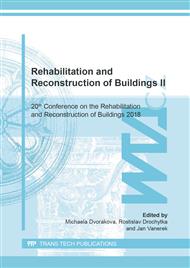[1]
M. de Bouw, I. Wouters, J. Vereecken, L. Lauriks, Iron and steel varieties in building industry between 1860 and 1914 – A complex and confusing situation resolved. Constr Build Mater 23 (2009), 2775-87.
DOI: 10.1016/j.conbuildmat.2009.03.009
Google Scholar
[2]
M. Holicky, Introduction to Probability and Statistics for Engineers, Berlin, Springer-Verlag, (2013).
Google Scholar
[3]
J. Hołowaty, B. Wichtowski, Remarks on the material testing of historical railway bridges, Steelworks built from 1873 to 1950. ce/papers 1 (2017), 1:4213-22.
DOI: 10.1002/cepa.479
Google Scholar
[4]
M. Sykora, M. Holicky, Probabilistic reliability assessment of industrial heritage – case study of a factory for boiler production, In Proc. STREMAH 2013, Ashurst Lodge, WIT Press, 2013, pp.171-82.
Google Scholar
[5]
M. Sykora, M. Holicky, Probabilistic assessment of a former factory for boiler production, In Proc. PROHITECH'14, Istanbul, Boğaziçi University Publishing, 2014, pp.469-74.
Google Scholar
[6]
JM. Holowaty, B. Wichtowski, Properties of structural steel used in earlier railway bridges. Struct Eng Int 23 (2013), 512-8.
DOI: 10.2749/101686613x13627347099999
Google Scholar
[7]
K. Jung, J. Markova, P. Pokorny, M. Sykora, Material Properties of Heritage Wrought Steel Structure Based on Tests. Int J Heritage Architecture 2 (2018), 128-37.
DOI: 10.2495/ha-v2-n1-128-137
Google Scholar
[8]
S. Heyde, J. Lindner, Investigations on historic grey cast-iron columns, In Proc. EUROSTEEL 2008, Brussels, ECCS Southampton, 2008, pp.1545-50.
Google Scholar
[9]
J. Rondal, K. J. R. Rasmussen, On the Strength of Cast Iron Columns. Sydney, Brookhaven National Laboratory, 2003; report no. R829, p.24.
Google Scholar
[10]
Rondal J, K.J.R. Rasmussen, On the strength of cast iron columns. Journal of Constructional Steel Research 60 (2004), 1257-70.
DOI: 10.1016/j.jcsr.2003.12.006
Google Scholar
[11]
B. Kühn, Helmerich R, Nussbaumer A, Günther HP, Herion S, Assessment of existing steel structures, recommendations for estimation of remaining fatigue life. JRC, 2007; report no. 77, p.89.
DOI: 10.1080/15732470500365562
Google Scholar
[12]
M. Sykora, M. Holicky, J. Markova et al., Probabilistic Reliability Assessment of Existing Structures (focused on industrial heritage buildings), Prague, Czech Technical University in Prague, CTU Publishing House, (2016).
Google Scholar
[13]
R. Caspeele, M. Sykora, D.L. Allaix, R. Steenbergen, The Design Value Method and Adjusted Partial Factor Approach for Existing Structures. Struct Eng Int 23 (2013), 386-93.
DOI: 10.2749/101686613x13627347100194
Google Scholar
[14]
M. Holicky, M. Sykora, J.V. Retief, Assessment of Model Uncertainties for Structural Resistance. Probabilist Eng Mech 45 (2016), 188-97.
Google Scholar
[15]
I. Brych, M. Holicky, K. Jung, M. Sykora, Uncertainty in resistance models for historic cast-iron columns (invited lecture at Int. Conf. STREMAH 2015), In Proc. SUSTAINABLE CITY X, Ashurst Lodge, WIT Press, 2015, pp.473-82.
DOI: 10.2495/sc150411
Google Scholar
[16]
I. Brych, M. Sykora, Assessment of Cast-Iron Columns Using Analytical Models. Appl Mech Mater 821 (2016), 782-8.
DOI: 10.4028/www.scientific.net/amm.821.782
Google Scholar
[17]
I. Wouters, I. De Graeve, D. Van de Velde, M. de Bouw, Q. Collette, Towards a non-destructive methodology to distinguish wrought iron from mild steel in 19th century structures, In Proc. Structural Repairs and Maintenance of Heritage Architecture XII, Ashurst Lodge, WIT Press, 2011, pp.285-93.
DOI: 10.2495/str110241
Google Scholar
[18]
S. Heyde, J. Lindner, Historic grey cast-iron columns - Analysis of structural safety and upgrade. Stahlbau 78(2009), 800-814.
Google Scholar
[19]
K. Jung, J. Marková, M. Sýkora, Evaluating Strength of Historic Cast Iron using Destructive and Non-destructive Tests, Extended Abstracts of 16th Int Probabilistic Workshop 2018 (IPW 2018) in Vienna 12-14 September 2018; Beton- und Stahlbetonbau 113(S2), September 2018, 141 (extended abstract).
DOI: 10.1016/j.conbuildmat.2018.10.180
Google Scholar
[20]
D. Friedman, Cast-Iron-Column Strength in Renovation Design. Journal of Performance of Constructed Facilities 9 (1995), 220-30.
DOI: 10.1061/(asce)0887-3828(1995)9:3(220)
Google Scholar
[21]
ISO 13822, Bases for design of structures - Assessment of existing structures.
Google Scholar
[22]
EN 1990, Eurocode – Basis of structural design, (2002).
Google Scholar
[23]
EN ISO 6892-1, Metallic materials - Tensile testing - Part 1: Method of test at room temperature, (2014).
Google Scholar
[24]
EN ISO 18265, Metallic materials - Conversion of hardness values, (2014).
Google Scholar
[25]
CSN 730038, Assessment and verification of existing structures – Supplem. guidance, (2014).
Google Scholar
[26]
CSN 42 0461, Metal testing. Methods for estimating the average grain size of steel and non-ferrous metals, (1983).
Google Scholar
[27]
CSN EN 1561, Founding - Grey cast irons, (2012).
Google Scholar


